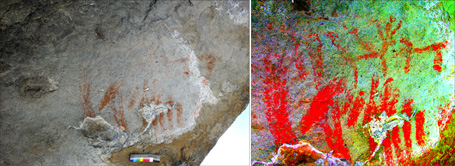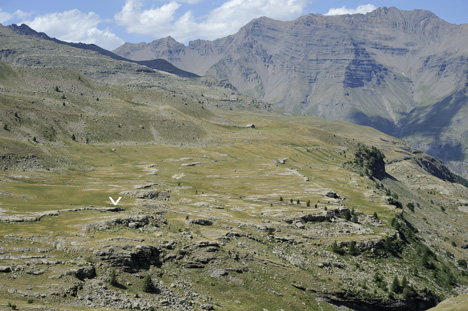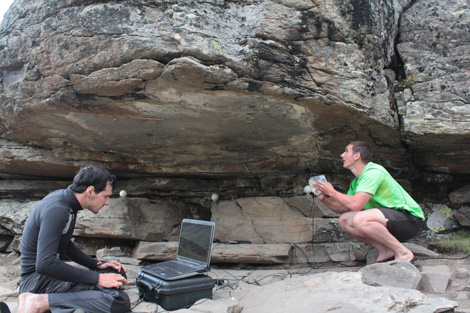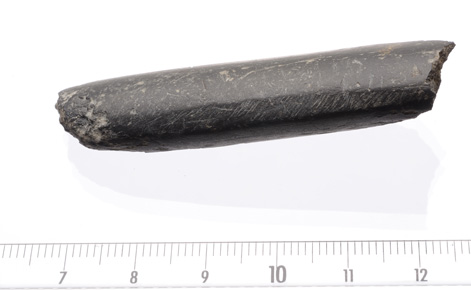High Rise Archaeology Identified with New Technology
Pioneering Scans of Prehistoric Paintings
Researchers from the University of York (Yorkshire, northern England), have carried out a series of pioneering scans of the highest prehistoric paintings known from Europe. Working at a fraction under 7,000 feet above sea level (2,133 metres), the team have been studying the rock art of Abri Faravel, a crude rock shelter discovered five years ago in the southern French Alps. The team used car batteries to power laser and white-light scanners in order to examine the ancient artworks.
Prehistoric Paintings
The Abri Faravel Rock Art

The paintings at the Abri Faravel. Two groups of roughly parallel lines, and two animals facing one another.
Picture credit: C. Defrasne
The picture above shows (left) a photograph of the rock art taken in normal light and (right) a closer view of the paintings – colours enhanced with DStretch with the YBR matrix.
From the Mesolithic to the Middle Ages
Writing in the open access, online journal “Internet Archaeology”, the team confirm that the rock shelter, located in the Parc National des Écrins, has seen phases of human activity since the Mesolithic up to Medieval times. The rock paintings are the highest (in terms of altitude) painted representations of animals known from the continent.
The Site of the Abri Faravel Rock Shelter Location

View and situation of the Abri Faravel from the south-east – location of the Abri Faravel indicated with an arrow.
Picture credit: Loïc Damelet, CNRS/Centre Camille Jullian
The white arrow, to the left of the centre of the photograph marks the location of the Abri Faravel rock shelter.
The Abri Faravel Rock Shelter
The Abri Faravel research forms part of a wider collaborative project between archaeologists from the University of York and colleagues from the Centre Camille Jullian, Aix-en-Provence, France. The long-running study had investigated the development of human activity over the last 8,000 years or so at a high altitude. Scientists have excavated a series of stone animal enclosures and human dwellings that date from the Bronze Age. However, older artefacts have been found, including Mesolithic and Neolithic flint tools as well as hand-thrown Iron Age pottery, a brooch dated to Roman times and some metalwork dating from the Middle Ages.
The paintings are regarded as the most unique feature of this site. They reveal a story of human habitation and activity from the Mesolithic to the Post-Medieval period.
The project leader, Dr Kevin Walsh (Senior Lecturer in York’s Department of Archaeology), commented:
“After years of research in this valley, the day we discovered these paintings was undeniably the highlight of the research programme. Whilst we thought that we might discover engravings, such as in the Vallée des Merveilles to the south-east, we never expected to find prehistoric paintings in this exposed area that affords so few natural shelters.”
Researchers Study the Rock Art by Taking a Series of Scans
Picture credit: Dr K. Walsh
High Rise Archaeology
Dr Walsh went onto say:
“As this site is so unusual, we made the decision to carry out a laser-scan of the rock shelter and the surrounding landscape, plus a white-light scan of the actual paintings. The scanning was logistically complex as our only source of electricity was car batteries, which, along with all of the scanning equipment, had to be carried up to the site. This is the only example of virtual models, including a scan of the art, done at high altitude in the Alps and probably the highest virtual model of an archaeological landscape in Europe.”
A Polished Neolithic Stone Axe Found Close to the Site
Picture credit: Guillaume Contini
Everything Dinosaur acknowledges the help of the University of York in the compilation of this article.
Visit Everything Dinosaur’s award-winning website: Visit Everything Dinosaur.



